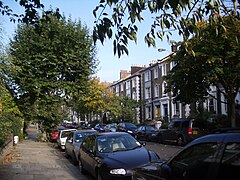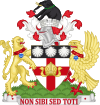Dartmouth Park: Difference between revisions
Philip Cross (talk | contribs) |
|||
| Line 36: | Line 36: | ||
==At present== |
==At present== |
||
Dartmouth Park is a quiet residential area with a mixture of residents, from young professionals and families through to retired couples. To the north lies the [[Holly Lodge Estate]] and then Highgate. Dartmouth Park is separated from Kentish Town to the south by the [[Gospel Oak to Barking Line|Gospel Oak to Barking]] railway line. Housing in Dartmouth Park is a mixture of detached and semi-detached houses, late Victorian and Edwardian mansion flats (notable examples include Brookfield Mansions and the blocks in Lissenden Gardens), and some post war housing such as Haddo House. |
Dartmouth Park is a quiet residential area with a mixture of residents, from young professionals and families through to retired couples. To the north lies the [[Holly Lodge Estate]] and then Highgate. Dartmouth Park is separated from Kentish Town to the south by the [[Gospel Oak to Barking Line|Gospel Oak to Barking]] railway line. Housing in Dartmouth Park is a mixture of detached and semi-detached houses, late Victorian and Edwardian mansion flats (notable examples include Brookfield Mansions and the blocks in [[Lissenden Gardens]]), and some post war housing such as Haddo House. |
||
The former park on the area covered what is now [[Waterlow Park]] and [[Highgate Cemetery]]. |
The former park on the area covered what is now [[Waterlow Park]] and [[Highgate Cemetery]]. |
||
Revision as of 14:11, 7 June 2016
Dartmouth Park is a district of north London in the London Borough of Camden, on the slope of the hill that rises up to Highgate from Kentish Town. On its west side, it borders Parliament Hill Fields.
History
Dartmouth Park is named after the Earl of Dartmouth who bought the land in the middle of the 18th century. The 5th Earl of Dartmouth instigated some major house building in the late 19th century, and the area has continued to undergo development since that time.

By then the need to increase the supply of fresh water to serve London's expanding population meant that water companies were building new facilities. Two covered reservoirs were constructed on Dartmouth Park Hill in 1855 by the New River Company and connected to its new waterworks and pumping station by Stoke Newington reservoirs. Later owned by the Metropolitan Water Board, the reservoirs are now owned by Thames Water Utilities.
The street named York Rise, which runs through the centre of Dartmouth Park, is in a slight valley which follows the course of the River Fleet, now underground. At the foot of York Rise the river crosses the railway tracks in a large iron pipe.
Architecture
Most of the area consists of late-19th century terraced and semi-detached houses, with a few more recent buildings. The local church is St Mary Brookfield, designed by William Butterfield and opened in 1875. It is red brick with contrasting yellow and blue brick patterns.
Park
Although the name designates a district and not a park per se, there is a small but attractive park off Dartmouth Park Hill, now named 'Dartmouth Park'. It was laid out on the edge of the reservoirs and opened to the public in 1972. Even as much of it is taken up by the reservoir tank, there is also a children's playground. The land slopes steeply to the north and the east of the reservoirs, which are now covered with lush grassland. The top of the slope gives an enchanting view of south-east London. The park has an enclosed seating area surrounded by a hedge, which local children helped to plant in 1991.
At present
Dartmouth Park is a quiet residential area with a mixture of residents, from young professionals and families through to retired couples. To the north lies the Holly Lodge Estate and then Highgate. Dartmouth Park is separated from Kentish Town to the south by the Gospel Oak to Barking railway line. Housing in Dartmouth Park is a mixture of detached and semi-detached houses, late Victorian and Edwardian mansion flats (notable examples include Brookfield Mansions and the blocks in Lissenden Gardens), and some post war housing such as Haddo House. The former park on the area covered what is now Waterlow Park and Highgate Cemetery.
Notable residents

- Julian Barnes, novelist
- Benedict Cumberbatch, actor and film producer, and his wife, theatre director Sophie Hunter
- Hunter Davies, writer
- Glenda Jackson, Labour MP
- Geoffrey Jellicoe, architect
- Ed Miliband, former Labour party leader and his wife Justine Thornton, environmental lawyer
- Richard D'Oyly Carte, opera impresario
- Dave Lee Travis, former Radio 1 DJ
- Lucy Rose, a folk musician
- Paul Smith, television writer
- Ken Loach, the film director
- Denny Wright, jazz guitarist
- Paco Pena, Flamenco guitarist
Past residents
- Margaret Forster, novelist and biographer
- Nova Pilbeam, actress
Transport

Nearest places
Nearest stations
References
- ^ "Sherlock homes in on Ed's patch". The Sunday Times.
- The Buildings of England London 4: North. Bridget Cherry and Nikolaus Pevsner. ISBN 0-300-09653-4.



